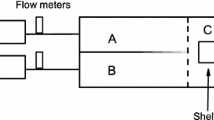Abstract
The effects of repetitive 24-hr weekly exposures to diflubenzuron (Dimilin®) on juvenile fiddler crabs (Uca pugilator) were studied in static seawater systems for 10 weeks. Crabs surviving the 10-week exposure period were maintained in clean seawater until death. Survival, molting, and behavior were monitored daily. The no-effect concentration (NOEC) for molting (time to the first molt), survival (time until death), and behavior (ability to escape from the test container) were 20, 2, and 0.2 μg/L DFB, respectively. The behavioral effect induced by diflubenzuron (DFB) exposures (>2 μg/L) was the most sensitive indicator of DFB activity and potentially may influence the ability of juvenile crabs to avoid predation, construct burrows, or feed adequately to survive in nature.
Similar content being viewed by others
References
Christiansen ME, Costlow JD (1982) Ultrastructural study of the exoskeleton of the estuarine crab (Rhithropanopeus harrisii): Effect of the insect growth regulator Dimilin® (diflubenzuron) on the formation of the larval cuticle. Mar Biol 66:217–226
Christiansen ME, Costlow JD, Monroe RJ (1978) Effects of the insect growth regulator Dimilin® (TH-6040) on larval development of two estuarine crabs. Mar Biol 50:29–36
Clark JR, Patrick JM, Moore JC, Forester J (1986) Accumulation of sediment-bound PCBs by fiddler crabs. Bull Environ Contain Toxicol 36:571–578
Costlow JD (1979) Effect of Dimilin ® on development of larvae of the stone crab (Menippe mercenaria) and the blue crab (Callinectes sapidus). In: Vernberg WB, Calabrese A, Thurburg FP, Vernberg FJ (eds) Marine pollution: Functional responses. Academic Press, New York, pp 355–364
Cunningham PA (1986) A review of toxicity testing and degradation studies for prediction of the effects of diflubenzuron (Dimilin®) on estuarine crustaceans. Environ Pollut Series A 40(l):63–86
Cunningham PA, Myers LE (1986) Dynamics of diflubenzuron (Dimilin ®) concentrations in water and sediment of a supratidal salt marsh site following repetitive aerial applications for mosquito control. Environ Pollut Series A 41(1):63–88
Cunningham PA, Wilson JEH, Evans DW, Costlow JD (1986) Effects of sediment on the persistence and toxicity of diflubenzuron (Dimilin®) in estuarine waters: A laboratory evaluation using larvae of two estuarine crustaceans In: Vernberg WB, Calabrese A, Thurburg FP, Vernberg FJ (eds) Pollution physiology of estuarine organisms. University of South Carolina Press, Columbia, South Carolina, pp 299–332
Forward RB, Costlow JD (1978) Sublethal effects of insect growth regulators upon crab larval behavior. Water Air Soil Pollut 9:227–238
Hester PG, Olson MA, Floore TG (1986) Effects of diflubenzuron on three estuarine decapods,Callinectes sp.,Palaemonetes pugio andUca pugilator. J Florida Anti-Mosquito Assoc 57:8–14
Hyman OW (1920) On the development ofGelasimus after hatching. J Morphol 33:485–525
Kalbfleisch JD, Prentice RL (1980) The statistical analysis of failure time data. John Wiley and Sons, New York
Krebs CT, Valiela I (1978) Effects of experimentally applied chlorinated hydrocarbons on the biomass of the fiddler crab,Uca pugnax. Estuarine Coastal Marine Sci 6:375–386
Marinucci AC, Bartha R (1982) Accumulation of the polychlorinated biphenyl Aroclor® 1242 from contaminated detritus and water by the salt marsh detritivor,Uca pugnax. Bull Environ Contam Toxicol 29:326–333
Mian LS, Mulla MS (1982) Biological and environmental dynamics of insect growth regulators (IGRs) as used against Diptera of public health importance. Residue Reviews 84:27–112
Nebeker AV, McKinney P, Cairns MA (1983) Acute and chronic effects of diflubenzuron (Dimilin ®) on freshwater fish and invertebrates. Environ Toxicol Chem 2:329–336
Odum WE, Woodwell GM, Worster CF (1969) DDT residues absorbed from organic detritus by fiddler crabs. Science 164:576–577
SAS Institute, Inc. (1985) SAS user's guide: Statistics. Version 5 edition. Cary, North Carolina
Ward DV, Howes BL, Ludwig DF (1976) Interactive effects of predation pressure and insecticide (Temephos) toxicity on populations of the marsh fiddler crabUca pugnax. Mar Biol 35:119–126
Weis JS (1976) Effects of environmental factors on regeneration and molting in fiddler crabs. Biol Bull 150:152–162
Williams AB (1984) Shrimps, lobsters, and crabs of the Atlantic Coast of the Eastern United States, Maine to Florida. Smithsonian Institute Press, Washington, DC
Wilson JE, Forward RB, Costlow (1984) Effects of embryonic exposure to sublethal concentrations of Dimilin® on the photobehavior of the grass shrimp larvae (Palaemonetes pugio) In: Vernberg FJ, Calabrese A, Thurburg FP, Vernberg WB (eds) Physiological effects of marine pollutant stress. University of South Carolina Press, Columbia, South Carolina, pp 377–396
Author information
Authors and Affiliations
Rights and permissions
About this article
Cite this article
Cunningham, P.A., Myers, L.E. Effects of diflubenzuron (Dimilin®) on survival, molting, and behavior of juvenile fiddler crabs,Uca pugilator . Arch. Environ. Contam. Toxicol. 16, 745–752 (1987). https://doi.org/10.1007/BF01055425
Received:
Revised:
Issue Date:
DOI: https://doi.org/10.1007/BF01055425




